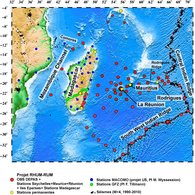
RHUM-RUM (Réunion Hotspot and Upper Mantle - Réunions Unterer Mantel) is a French-German passive seismic experiment designed to image a classical oceanic mantle plume – or lack of plume – from crust to core beneath Réunion Island. The results enable insights into the material and heat flow in the Earth's deep interior and provide a geodynamic context for the still controversially debated deep mantle plumes.
Time frame
- 2014 - 2017
Funding
- DFG - Deutsche Forschungsgemeinschaft (STE 907/11-1)
Principal Investigators
Personnel
Project website www.rhum-rum.net/en/
Cooperations
- Guilhem Barruol, IPG Paris & Géosciences Réunion, France
- Karin Sigloch, University of Oxford , UK

Project details
Modelling the mantle plume underneath Réunion Island in the Indian Ocean is a valuable contribution to the RHUM-RUM project, because the plume in a geodynamic model can be studied in a dynamic context - in contrast to seismic tomography. The present-day model state can be regarded as a "true" prediction for the dynamics in the Earth's interior und can therefore be compared to the seismic results.
Publications/Results
- Bredow, E., B. Steinberger, R. Gassmöller, and J. Dannberg (2017), How plume-ridge interaction shapes the crustal thickness pattern of the Réunion hotspot track, Geochem. Geophys. Geosyst., 18, 2930–2948, doi:10.1002/2017GC006875.


